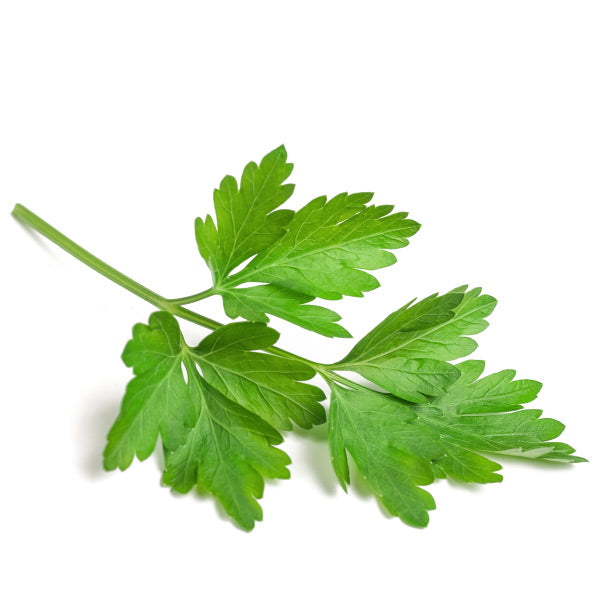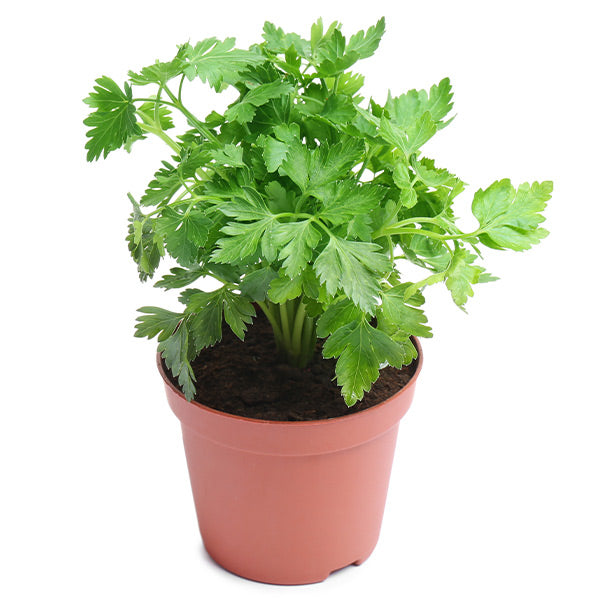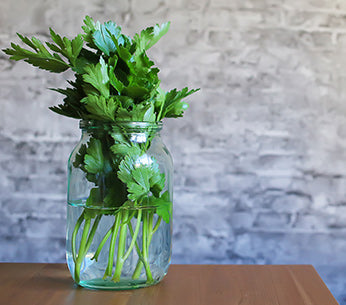How to Grow Parsley Herb from Seed
- Latin Name: Petroselinum crispum
- Hardiness Zone: Annual, Biennial Zone 5-9
- Days to Harvest: 30-40 days (from date of transplanting)
- Days to Maturity: 2nd Year
- Days to Germination: 14-35 days
- Seeding Depth: ¼"
- Plant Spacing: 12-15"
- Plant Height: 12-18"
- Growth Habit: Weedy and upright similar to dill or fennel
- Soil Preference: Consistently moist, cool, well-drained
- Temp Preference: Cooler, 60-65°F
- Light Preference: Full sun - Partial shade
- Pests/Diseases: Like many herbs, parsley is not susceptible to many pests or insects, but can experience stem rot and Septoria leaf spotting in poorly drained soil.
- Availability: See All Parsley Seed Varieties

>>> See Full Herb Grow Guide List <<<
Growing Parsley
Whether growing French curly, Italian flat leaf, or the uniquely bulbous Hamburg rooted, garden parsley delivers one of the mildest, yet complex culinary herbs available and grows very similar to cilantro and other herbal favorites in the genus Apiaceae. Parsley is one of the most ideally suited herbs to grow indoors near a sunny window because parsley is an annual requiring cool summers, partial shade, and consistently moist soil, all of which can be easily managed indoors. If allowed to flower and go to seed, you’ll quickly see parsley develop a 24-36” tall flowering umbel just like its relatives dill, fennel and Queen Anne’s Lace (wild carrot)

For the earliest starts, begin seeds indoors 10-12 weeks prior to your final regional frost, then transplant to the garden or individual pots 7-8 weeks later. Parsley prefers the cool weather and thrives from being transplanted in early spring with full sun. Unlike many fruits and vegetables, herbs such as parsley seeds are known to have a fairly slow germination of anywhere from 14-35 days. Plant 2-3 parsley seeds ¼” deep per individual cell or sow directly in a well-drained pot if intending to try container gardening for the season. If growing parsley in a container or pot, be sure to provide plenty of soil for its 8-10” taproot during the first year, which grows deeper if allowed to mature as a true biennial. Although parsley prefers consistently moist soil, be sure that the soil is still well-drained to prevent stem rot and Septoria leaf spotting. Parsley only requires a minimal 2 fertilizer feedings a season since it is neither woody or intended to flower.
Is Parsley A Perennial?
No. Like many species in the herbal genus Apiaceae such as cilantro, dill, and fennel, garden parsley is a biennial that is most commonly grown as an annual for culinary use. As a true biennial, parsley will produce all of its tender, edible, and flavorful greens the first year and, after a period of winter dormancy, the mature parsley plant will then produce its flowers and seed, thus completing its two-year lifecycle. Parsley is not traditionally allowed to grow as a culinary biennial because, like any plant that goes to flower and seed, the leafy greens will have become too bitter and coarse for any type of culinary use. Parsley has a thick and durable root which can be uprooted from the garden and transplanted indoors just before the winter.
Growing Parsley in Pots
Parsley is one of the most popular herbs for container gardening because the convenience and portability of containers allows for gardeners to easily move their plants day-to-day for optimal conditions. Parsley grown in a container can be brought indoors for protection during torrential summer heat or can be kept outdoors and moved into shade. Plants that produce taproots are not typically ideal for container gardening because it can be challenging to accommodate for the deeper root structure. Since culinary parsley is traditionally ever grown as a short-lived annual, its root development shouldn’t extend much deeper than 8” which is a very manageable size for many pots and planters. If choosing to maintain parsley in a moveable pot rather than in the garden bed, be sure to attentively water since containers are popularly used to ensure thorough drainage. Never use terra cotta or any clay-based pots when growing parsley because the porous containers are almost guaranteed to dehydrate parsley of some much needed moisture.

Growing Parsley Indoors
As mentioned, parsley is an ideal candidate for indoor growing. Unlike some of the woodier and perennial herbs like rosemary and lavender, parsley is a more tender herb which can benefit from the climate control and consistent watering if grown indoors. Parsley naturally prefers cool springs and partial shade during overly hot summers and is popularly grown in pots and containers so that it can be easily moved to capture optimal conditions. Regardless of cultivar, parsley requires consistently moist and well-drained soil, which can be challenging to maintain when grown in the garden or unprotected summer heat. Even parsley grown indoors will still benefit from some time spent outdoors in the cool morning sun, only to be brought back in once the midday heat arrives. When growing parsley in a container, be sure to provide plenty of soil for its 8-10” taproot development in its first year.
Propagating Parsley
Perennial herbs such as rosemary, lavender, and thyme are widely known to be much easier to propagate from cuttings rather than seed. Tender and leafy annual herbs such as parsley are actually just as easily propagated from seed as it is from a cutting of a more established plant. Although experience and knowledge with general plant cloning is always beneficial, be sure to treat parsley with a little extra care because it will not propagate exactly in the same way that you’re likely familiar with more woody and frost hardy perennial herbs. Fresh parsley cuttings will appear to be wilting for the first couple days after being transplanted. Propagating parsley from cuttings is still simple, provided there are a few slightly different steps.
1. Clip a 5-6” stem that has neither gone to flower nor showing signs of yellowing. Remove the bottom 2-3” worth of leaves from the cutting and immediately place that 2-3” in a glass of water.
2. While the bare end of the stem soaks for about 2 hours, prepare the soil with equal parts potting soil, perlite, and peat moss to best help the soil retain moisture without waterlogging.
3. Once the stem has finished soaking and you are ready to transplant, use your fingernails to lightly strip away the soft exterior of the stem to better expose parsley to nutrients in the soil.

4. Depending on preference, stems may either be dipped in a rooting hormone just before moving to soil or the stems may be transplanted directly without any rooting powders or gel.
Parsley Companion Planting
Parsley is usually found growing in tandem with cilantro and other members of Apiaceae because they share very similar habits and grow conditions. Unlike some of the most fragrant herb crops, parsley contains all of its vital and fragrant essential oils from its seed rather than its vegetation. In that respect, parsley is not generally grown as a heavily aromatic deterrent for garden pests the way that other herbs are, despite that established parsley still has very few pests or insect problems. Parsley thrives as a companion plant when allowed to flower in its second year, attracting many beneficial insects, pollinators, bees, and hummingbirds. Believing it boosts flavor and vigor, many home gardeners traditionally plant parsley near Allium (onion, garlic, chives) and Solanum (tomatoes) crops and even, most commonly, rose bushes.
How to Harvest Parsley
Although having a very different appearance from one another, harvesting Italian flat leaf and French curly parsley are both effortless and share the same exact steps despite differences. If growing both varieties in the garden for harvesting, remember that Italian flat leaf is widely considered the more flavorful of the two while the French curly is the preferred variety for garnishing and ornamental greens.
When harvesting parsley, the most challenging part at first may be to understand the difference in leaf pinnation and how that affects harvesting certain herbs. Pinnation refers to the fan-like or feathering habit of a leaf’s structure. Parsley is a tripinnate that has a very noticeable triangular shape to its leaf structure. To truly discuss leaf pinnation would require an entire article involving several plants typically not found in the home garden.
- Harvest parsley leaves that are green, firm, and whose stalk has yet to go to bloom.
- A leafy parsley stem will always grow in a three segment pinnation like (tripinnate) and only the middle pinnate, or middle grouping of leaves should be harvested to allow the two other grouping of leaves to continue growth.
- Parsley is tender and the soft pinnate of leaves may simply be harvested with your fingers.
Parsley Flowers
Unlike some vegetable crops such as flowering kale or cabbage, parsley does not produce any traditional blooming flowers used in fresh cut arrangements and centerpieces. As a biennial, parsley is not a strong candidate for floral design because the mature plant will only produce a flowering head during its second and final year in the garden. Parsley is an umbellifer and member of genus Apiaceae responsible for bulbous and umbrella-like flowering heads (umbels) identical to other umbellifers anjelica, carrot, celery, and dill. Although parsley is not known for producing fresh cut blooms, it's Apiaceae relative Queen Anne’s Lace (wild carrot) is used extensively in the floral industry and produces large and white blooming umber heads nearly identical to parsley. Allowing parsley to grow as a biennial and produce flowers in its second year will attract just as many beneficial insects and birds to the garden as any true wildflower.

Drying Parsley
Parsley leaves are very thin, minor, and should even begin to air dry as soon as they’re clipped from the plant. Although food dehydrators and ovens are commonly used to dehydrate other herbs, parsley is arguably best when left to air dry, either traditionally hanging upside down, left out on the kitchen counter, or stored in a Mason jar to be used when necessary. Parsley is just as easy to grow as any other herb, requiring nothing more than a little patience.
- Hang Dry: Like any garden herb, cut about 5-6” of fresh growth per stem and bundle together. Hang the small parsley bundle upside down in a dry, cool, and well-ventilated area. Herbs will not properly dry in overly humid spaces.
- Oven Dry: Leaves can be dehydrated in a convection oven at 175° F for 2 hours or until parsley is brittle, cracking, and has lost its color.
- Food Dehydrator: Herbs, fruits, and flowers are ideal for countertop food dehydrators for reliable and thorough drying. Food dehydrators feature step-by-step instructions for herbs and is the preferred method for many cooks and home gardeners.
Benefits of Parsley
Although once touted as a curative ancient medicinal herb, parsley has since been resigned to more culinary uses celebrated for complexities of flavor rather than purported medicinal uses. Despite its sole purpose now as a culinary herb, just a half cup of freshly chopped parsley contains about 50% of the Recommended Daily Intake (RDI) of Vitamin C, more than 100% of Vitamin A, and more than 500% RDI for Vitamin K, which is directly responsible for blood coagulation and hemorrhagic diseases. Parsley is rich in antioxidants and, when extracted from seed, parsley oil is a proven antibacterial.
Types of Parsley
Some herbs such as basil, mint, or sage can seem to have a nearly endless selection of unique cultivars each boasting their own exotic flavors and habits while parsley, on the other hand, is known for about 3 different varieties that each promise their own flare in the kitchen and garden. Regardless of preferred variety, each cultivar of parsley promises tender and flavorful leaves and all thrive in the same exact growing conditions.
- Italian Flat Leaf - Widely considered the strongest, most flavorful, and preferred culinary variety, Italian flat leaf produces a wide and flat leaf that looks somewhat similar to cilantro. Store bought parsley seasonings are exclusively made from this robust cultivar.
- French Curly - Known for a more subtle and muted flavor profile, French parsley is almost synonymous with garnishings, found in nearly every restaurant in the country as an ornamental accompaniment on many entrees.
- Hamburg Rooted - The most exotic and underappreciated cultivars of parsley, the Hamburg parsley boasts a large and wide 10” taproot that is harvested like any carrot or parsnip. The root can be substituted in any dish that calls for root vegetables and has a subtle flavor profile often likened to celery. Just like Italian and French, the Hamburg can be harvested for tender green vegetation with flat Italian-like leaves.

Parsley Tea
If growing parsley for culinary use and tea, it is best to harvest young and tender leaves which will be more flavorful and aromatic. Like all fresh herbs, garden parsley tea is easy to brew and takes no longer than 10 minutes just like any other pot of tea. Parsley leaves may be used raw and fresh from the garden or may be dried and stored for later use. Parsley tea is often enjoyed plain or with a touch of lemon, honey, or sugar. How to brew Parsley Tea:
1. Using any type of tea infuser or tea bag, add about 4 tsp of freshly dried parsley to every 8 oz of boiled water. Can be brewed individually or with an assortment of herbs.
2. Allow parsley leaves to steep for about ten minutes.











